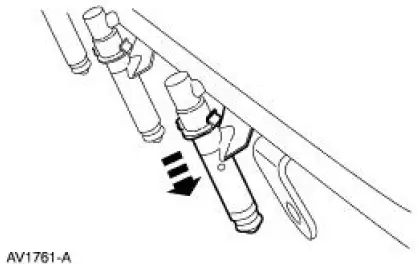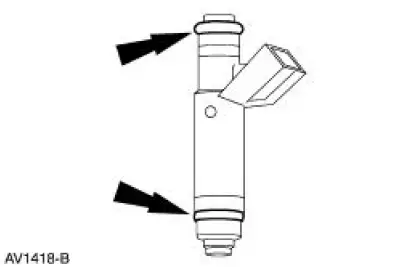Ford Mustang (1999-2004) Service Manual: Fuel Injectors
Removal
WARNING: Do not smoke or carry lighted tobacco or open flame of any type when working on or near any fuel related components. Highly flammable mixtures are always present and can ignite. Failure to follow these instructions can result in personal injury.
WARNING: Fuel in the fuel system remains under high pressure even when the engine is not running. Before working on or disconnecting any of the fuel lines or fuel system components, the fuel system pressure must be relieved. Failure to follow these instructions can result in personal injury.
1. Remove the supply manifold. For additional information, refer to Supply Manifold in this section.
2. Remove the eight fuel injectors from the supply manifold.

Installation
CAUTION: The retaining clip must be in the upper groove on the injector or the injector can become loose.
1. NOTE: Inspect the two O-rings from each fuel injector. Install new O-rings as needed.
NOTE: Lubricate the new O-rings with clean engine oil.
To install, reverse the removal procedure.

 Throttle Body
Throttle Body
Removal
WARNING: Do not smoke or carry lighted tobacco or open flame of any
type when
working on or near any fuel related components. Highly flammable mixtures are
always present
and can ignite. Fai ...
 Wiring Harness
Wiring Harness
...
Other materials:
Cylinder Head
Special Tool(s)
Compressor, Valve Spring
303-163 (T81P-6513-A)
Material
Item
Specification
SAE 5W-20 Premium Synthetic
Blend Motor Oil
XO-5W20-QSP or equivalent
WSS-M2C153-
H
Disassembly and Assembly
CAUTION: If the com ...
Air Conditioning (Description and Operation)
The A/C refrigerant system is a clutch cycling orifice tube type. The system
components are:
A/C compressor (19703)
A/C clutch (2884)
A/C condenser core (19712)
A/C evaporator core (19860)
suction accumulator (19C836)
connecting refrigerant lines
The ...
Actuator Cable - Speed Control-Cobra
1. Remove the speed control actuator cable end from the throttle body.
1. Lift the speed control cable from the throttle nailhead.
2. Release the speed control cable from the throttle bracket.
2. Remove the speed control cable from the retaining cli ...
